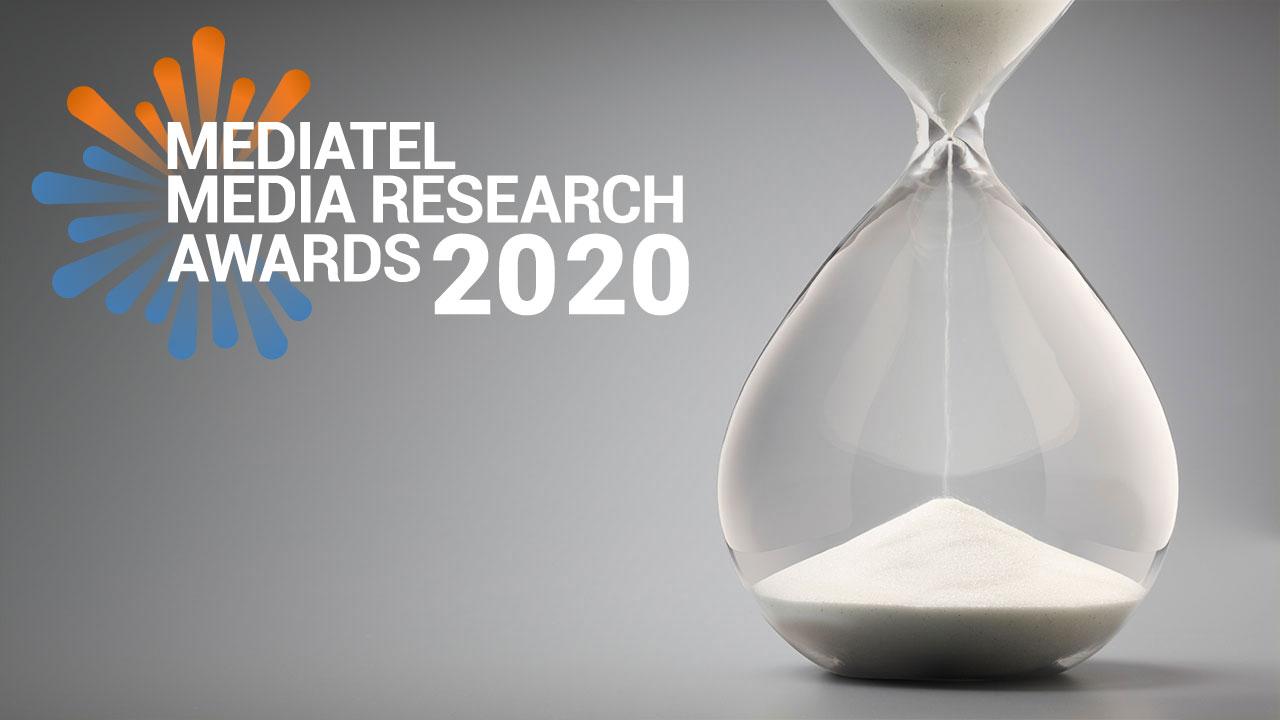Can you really tell a story in a few seconds? Work Research investigated the impact of time-length in TV advertising.
In Brief
What’s the impact of time length in TV advertising? Do you need a mix of short and long ads? Can you tell a story in less than 10 seconds?
These are some of the most common questions about TV advertising – and for good reason.
We’ve long known the power of story-telling in advertising. The ability to connect emotionally with viewers is one of the fundamental drivers of TV’s effectiveness for brands.
But as video has become ubiquitous across platforms, we need to broaden our understanding of AV to understand if conventional copy-length wisdom still applies.
The research agency Work undertook a small-scale study that explored the role of time in TV advertising and importantly, its relationship with storytelling. Given the study’s size, we can’t claim it’s representative of how all ads of varying length work, but we believe it to be a good indication.
Key findings
- Longer ads have benefits over shorter executions
- Longer ads act as memory ‘anchors’
- Longer ads enhance image memory
- Brand awareness decays faster than brand perception
Methodology
Although the question of time-length is one that’s enduring within media research, there is relatively little research out there. Why? Because the impact of previous brand experience and past exposure cannot be underestimated. It’s virtually impossible to extrapolate those elements from the creative effects unless you start with an entirely new brand.
Creating a new, fake brand, however, is hard to do convincingly without a ‘proper’ proposition and some serious cash for the creative.
Partnering with Walnut, Work Research devised a research framework that managed to jump the biggest hurdles of this kind of research.
Firstly, they selected four existing creative treatments (three emotional and one rational) for brands that were unknown in the UK but sat within categories that were very familiar. These were retail, insurance, broadband and washing detergent.
Just to be certain, a team of real-life ad agency creatives tweaked the brands, giving them new identities. This way, we could be sure that none of the respondents had any previous brand history that could muddy the results.
Next, the team of creatives formed a set of cut-downs for each using exactly the same processes they would for any of their clients. These cut-downs were then vetted by several different teams to ensure that creatively, they made sense and were fair representations of the original ads. Time-lengths were categorised as follows:
- Long: 60”
- Medium: 30”
- Short: 10”, 6” or 5”
Finally, each of the ads were taken into an online test where each iteration was shown, in amongst a reel of other ad ‘clutter’, to 200 people each.
They were tested against two factors:
- Explicit perception statements (to see what people thought and consciously remembered about the brands)
- Implicit brand perceptions tests (to understand what people felt about them or thought they just knew for themselves)
The latter was tested via ‘IRT’ (Implicit Reaction Testing). If someone truly believes or disbelieves something, their initial reaction tends to be strong and automatic. The more doubt they have the slower the reaction time as the brain must consciously consider what is being processed and this slows the response down.
Around half of the respondents were tested again several days later. Some saw the ad repeated (either full length or cut-down) again whilst others didn’t which gave an indication of the decay rate for the measured effects.
Findings
1. Longer ads have benefits over shorter ones
Longer ads delivered a 42% uplift to explicit brand statements over short ones and were therefore, unsurprisingly, better at delivering a greater volume of information.
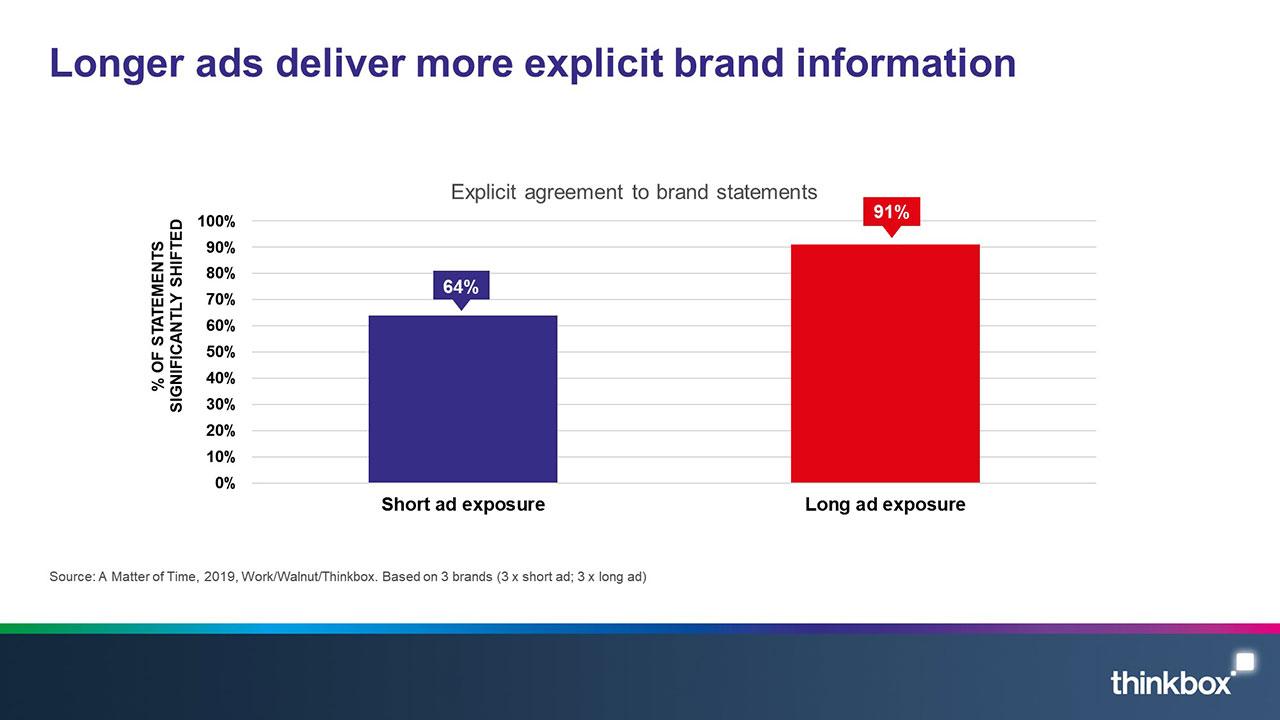
Longer ads worked much harder at an implicit level, however, where they almost doubled the implicit effects over short ads. The longer ads were evidently shifting brand feeling and sentiment more effectively, which is especially poignant when you consider that these brands were totally unknown to the respondents.
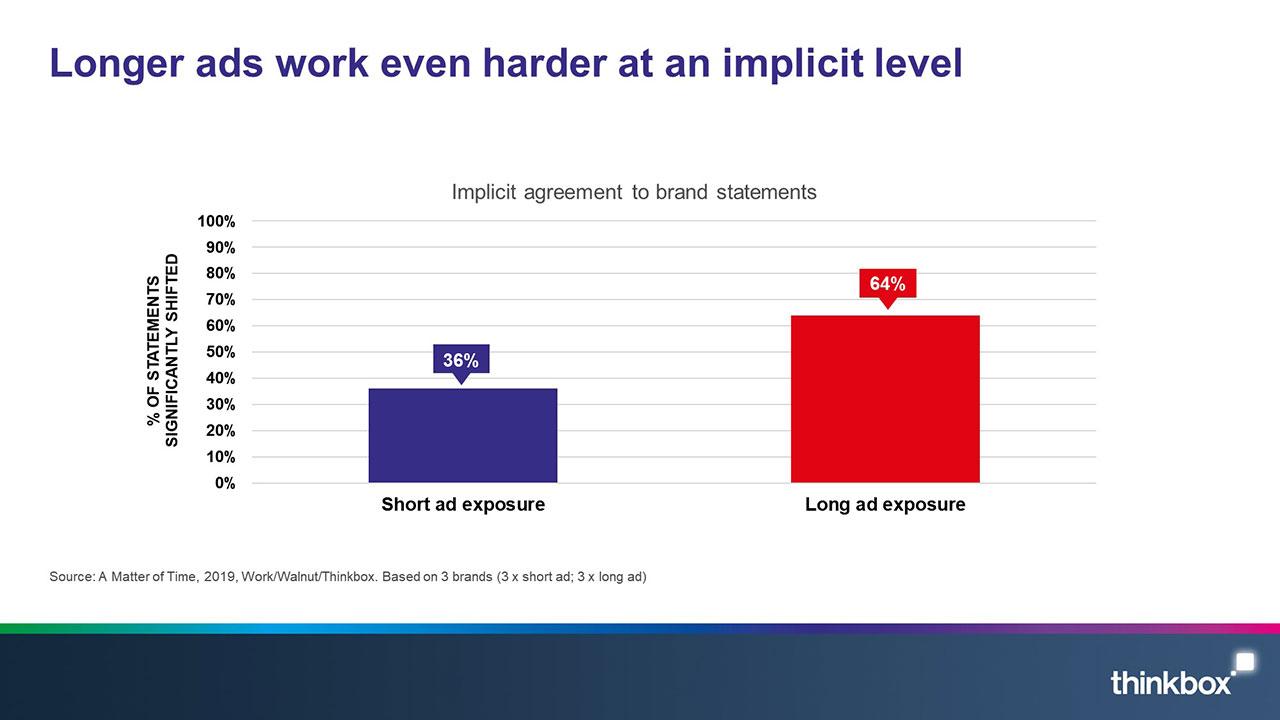
2. Longer ads act as memory ‘anchors’
Our brains are programmed to seek out, respond to and remember stories. Storytelling has helped us learn, educate and evolve since the dawn of humanity. Stories engage more of the brain and create universal patterns that transcend culture and language. But how does this relate to copy-length?
Our brains like order - and if there is no order they try to create it. If there are gaps in information, our brains fill them in. That is why two people can have very different recollections of the same event. We rely on ‘reconstructive memory’ to fill in the blanks and make sense of what we’ve experienced.
In advertising terms, this means that the longer ads often have a stronger sense of narrative and are therefore more comprehensive. There are fewer gaps for our brains to fill in and advertisers have more control over how their brand is perceived.
Behavioural science shows us that product experience is inherently tied to brand memory (see our study From Brand to Bland). An enhanced brand memory is likely to result in a positive brand experience.
Longer ads therefore act as ‘anchors’ for our memory, providing the basis for positive brand memory and reducing the need for reconstructive memory to kick in.
They also do this at relatively little cost. When a short ad is seen after a long ad, there’s a 51% uplift in explicit memory effects versus just 9% for seeing a short ad in isolation. This is including a gap of several days between viewing the ads and testing.
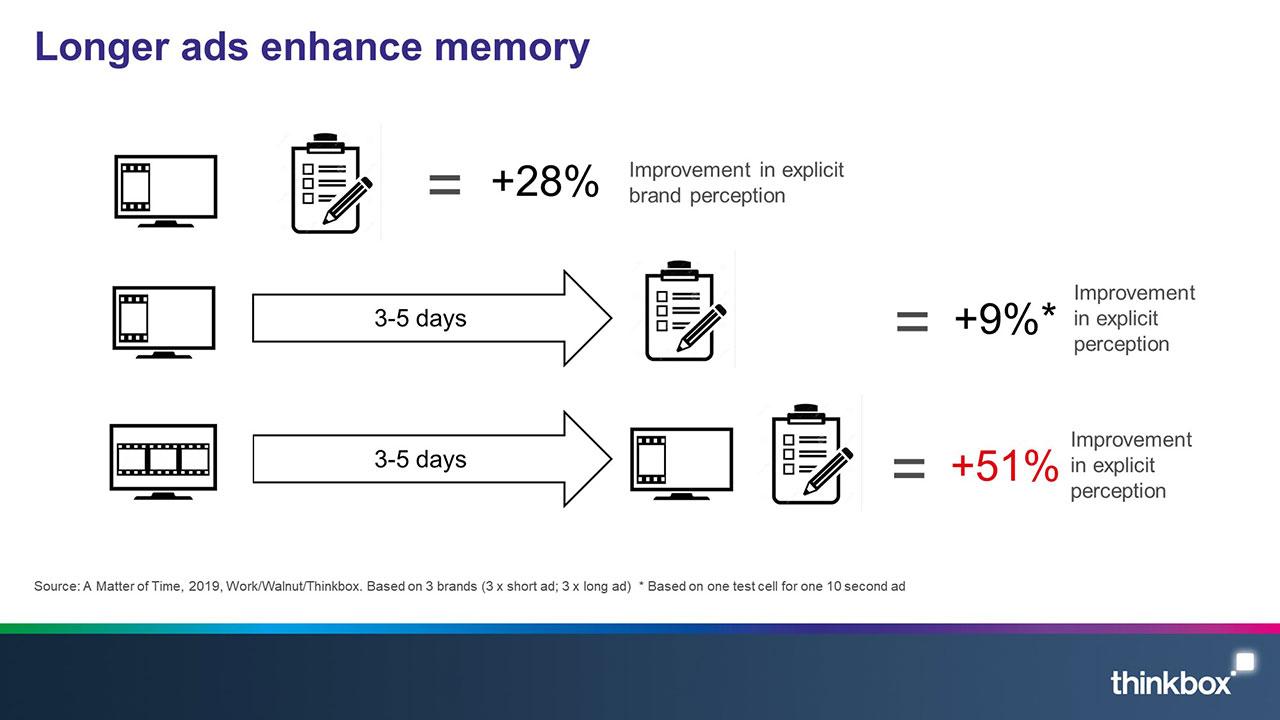
3. Longer ads enhance image memory
Our brains don’t work like video cameras. We evoke memories by storing still snapshots of events. This is why iconic imagery is so crucial to TV advertising and building effective brands. Both context and narrative are key drivers of brand memory and these inherently come from strong brand stories.
In our experiment, the same imagery was included in both the long and shorter ads, for a similar duration of time in each instance.
However, the memory of key scenes in the longer ads was 37% higher (based on the average indices of all ads where same scenes are in both long and short versions) than it is for the shorter ads.
This shows that the narrative context is hugely influential in driving the recall of iconic imagery and the narrative context is enhanced through longer ads.
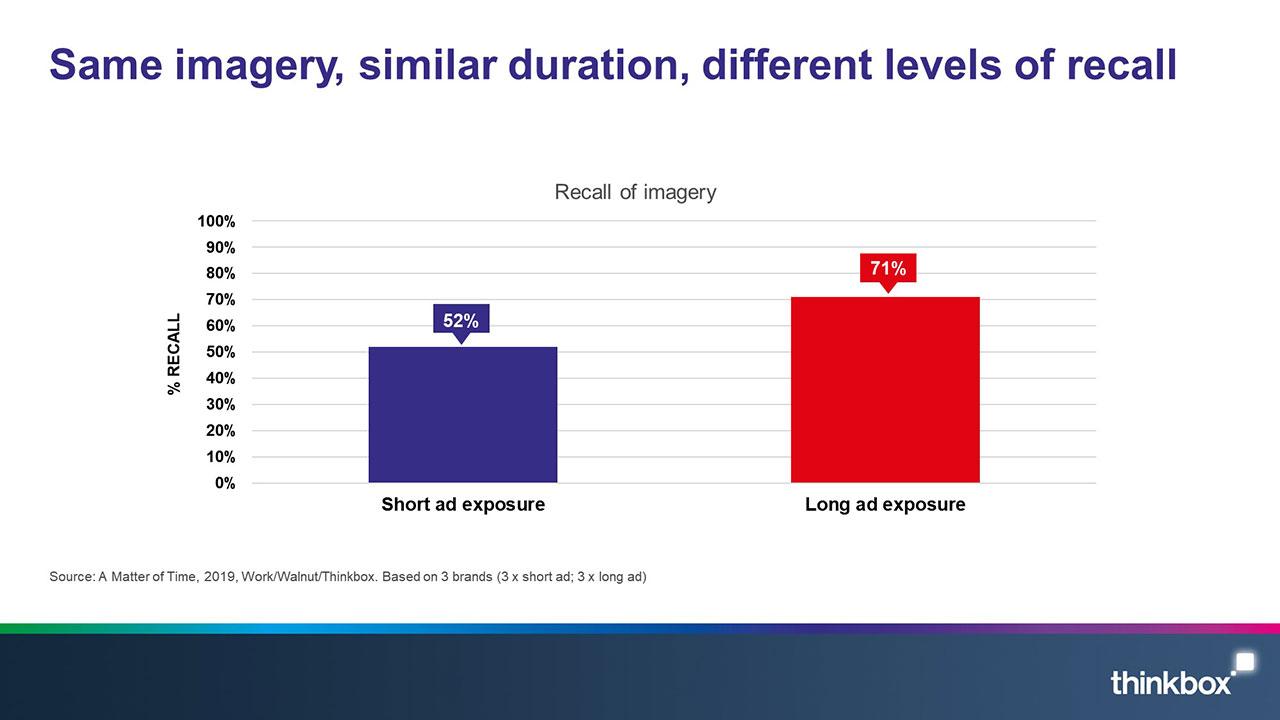
4. Brand awareness decays faster than perception
We also discovered that the metrics most commonly tracked as indicators of brand health – spontaneous and prompted brand awareness – decay much faster than the implicit and explicit brand perception measures. There was 87% and 83% decay respectively for spontaneous and prompted brand awareness several days after the first exposure versus 20% decay for implicit perceptions and 18% for explicit.
Implicit memory of scenes from ads also decayed more slowly at around twice the rate that brand perceptions did. In other words, people remember the key messages and feelings towards a brand and the visuals of the ad over the brand’s name.
This highlights the importance of emotion in advertising and also supports Heath’s theory of Low Attention Processing – that even when we are paying relatively little attention to ads, we’re still forming a set of associations and feelings around brands that endure beyond exposure even if we can’t consciously recall the brand name.
Given that this study was looking at just one or two exposure of a previously unfamiliar brand, it demonstrates the narrative power of advertising in shaping brand associations and the importance of harnessing the power of storytelling to drive those associations in the most positive manner. It also supports the findings of our previous study, Creative Drivers of Effectiveness, which proves that branding works best when interwoven into the narrative of an ad rather than placed at the end frame.
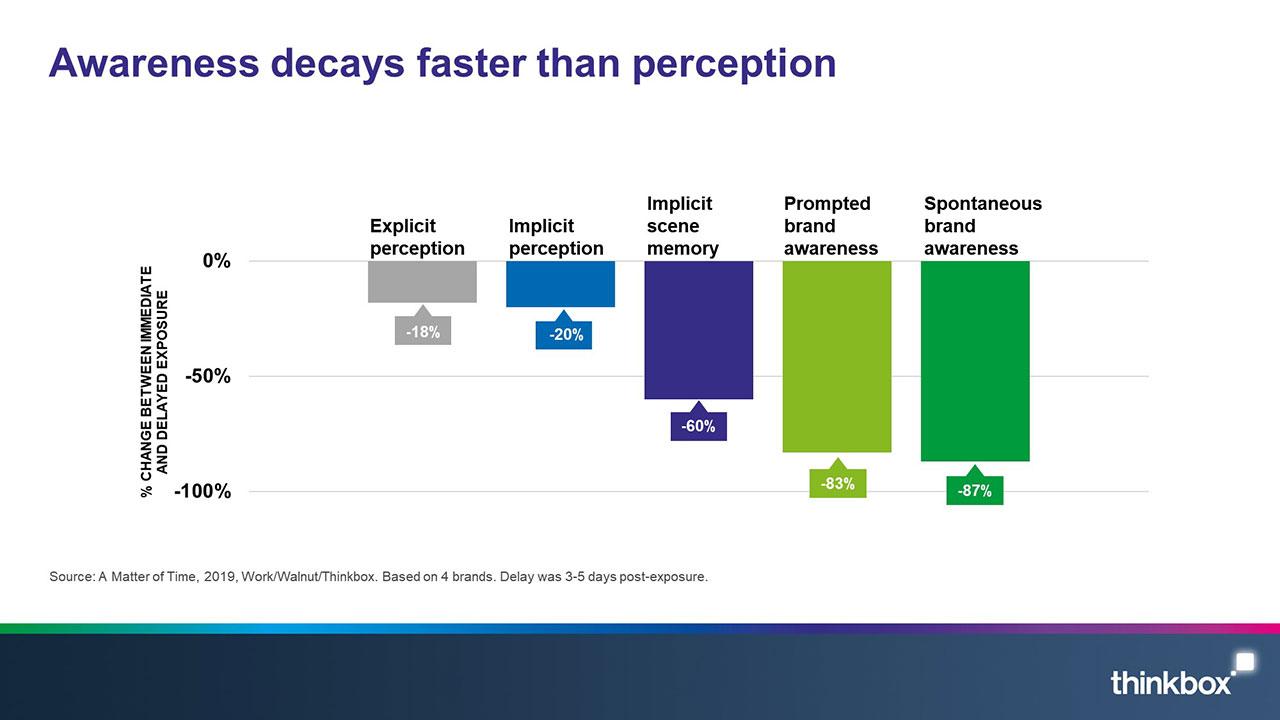
In summary
We know that there is a place for both long and short executions in TV advertising, but the trick is to utilise the strengths of both.
Longer ads are better at building narratives than shorter ads and storytelling is the cornerstone of TV’s effectiveness. Because of this, they are also better equipped to drive positive brand perceptions – especially implicit associations – than shorter ads. Longer executions act as effective memory anchors. This increases the effectiveness of shorter executions and affords advertisers have greater control over the way their brands are perceived. Shorter ads therefore work best when placed after longer executions.
We know that brand perceptions are crucially important, not least because brand awareness is the measure that decays the fastest.
 Thinkbox
Thinkbox